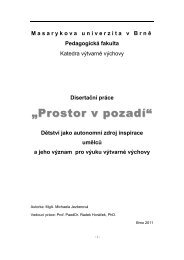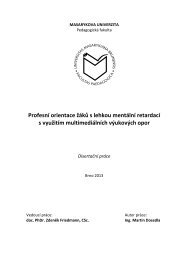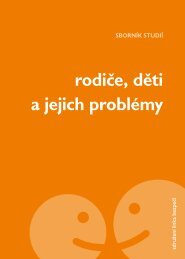Bjarnason, T., Andersson, B., Choquet, M., Elekes, Z., Morgan, M., & Rapinett, G.(2003). Culture,family structure and adolescent alcohol use: multilevel modeling <strong>of</strong> frequency <strong>of</strong> heavy drinkingamong 15–16 year old students in 11 European countries. Journal <strong>of</strong> Studies on Alcohol, 64, 200–208. Získané z http://www.ncbi.nlm.nih.gov/pubmed/12713193Blatný, M., Hrdlička, M., Květon, P., Vobořil, D., & Jelínek, M. (2004). Výsledky české částimezinárodního projektu SAHA I.: deskriptivní analýza rizikového chování a rizikových a protektivníchfaktorů vývoje mladistvých z městských oblastí. Zprávy - Psychologický ústav Brno, 10(1), 35.Blatný, M., Hrdlička, M., Sobotková, V., Jelínek, M., Květon, P., & Vobořil, D. (2006). Prevalenceantisociálního chování v obecné populaci českých adolescentů z městských oblastí. Československápsychologie, 50(4), 297 – 310.Blatný, M., Polišenská, V.A., Balaštíková, V., & Hrdlička, M. (2005). Problematika rizikového chovánívývoje dětí a dospívajících: hlavní témata a implikace pro další výzkum. Československá psychologie,49(6) 524- 539.Bohnert, A. M., Crnic, K. A., & Lim, K. G. (2003). Emotional competence and aggressive behavior inschool-age children. Journal <strong>of</strong> Abnormal Child Psychology, 31(1), 79-91.Získané z http://www.ncbi.nlm.nih.gov/pubmed/12597701Bond, L., Butler, H., Thomas, L., Carlin, J., Glover, S., Bowes, G., & Patton, G. (2007). Social and schoolconnectedness in early secondary school as predictor <strong>of</strong> late teenage substance use, mental health,and academic outcomes. Journal <strong>of</strong> Adolescence Health, 40(4), 357.e9-18.Získané z http://www.ncbi.nlm.nih.gov/pubmed/17367730Bonino, S., Cattelino, E., & Ciairano, S. (2005). Adolescents and risk. Behaviors, functions, andprotective factors. New York: Springer. ISBN: 8847002907Booth, A., Amato, P. R. (2001). Parental predivorce relations and <strong>of</strong>fspring postdivorce well-being.Journal <strong>of</strong> Marriage & the Family, 63, 197–212. doi: 10.1111/j.1741-3737.2001.00197.xBowker, A., Bukowski, W. M., Hymel, S., & Sippola, L. K. (2000). Coping with daily hassles in the peergroup in early adolescence: Variations as a function <strong>of</strong> peer experience. Journal <strong>of</strong> Research onAdolescence, 10, 211 – 243. doi:10.1207/SJRA1002_5Brackett, M. A., & Katulak, N. A. (2007). Emotional intelligence in the classroom: Skill-based trainingfor teachers and students. In J. Ciarocchi, J.,& J.D. Mayer, (Eds.), Applying emotional intelligence: Apractitioner's guide (p. 1-27). New York: Psychology Press/Taylor & Francis. Získané zhttp:// heblab.sites.yale.edu/.../pub101_BrackettKatulak2006TheEIclassroomBrackett, M. A., & Mayer, J. D. (2003). Convergent, discriminant, and incremental validity <strong>of</strong>competing measures <strong>of</strong> emotional intelligence. Personality and Social Psychology Bulletin, 29, 11471158. doi: 10.1177/0146167203254596Brackett, M. A., & Salovey, P. (2004). Measuring emotional intelligence as a mental ability with theMayer-Salovey-Caruso Emotional Intelligence Test. In. G. Geher (Eds.), Measurement <strong>of</strong> EmotionalIntelligence (pp. 179-194). Hauppauge, NY: Nova Science Publishers.146
Brackett, M. A., Lopes, P., Ivcevic, Z., Mayer, J. D., & Salovey, P. (2004). Integrating emotion andcognition: The role <strong>of</strong> emotional intelligence. In D. Dai & R. Sternburg (Eds.), Motivation, emotion,and cognition: Integrating perspectives on intellectual functioning (pp. 175-194). Mahwah, NJ:Erlbaum. ISBN: 978-0-8058-4557-0Brackett, M. A., Mayer, J. D., & Warner, R. M. (2004). Emotional intelligence and its relation toeveryday behaviour. Personality and Individual Differences, 36, 1387-1402.doi:10.1016/S0191-8869(03)00236-8Brackett, M. A., Rivers, S., Shiffman, S., Lerner, N., & Salovey, P. (2006). Relating emotional abilitiesto social functioning: A comparison <strong>of</strong> self-report and performance measures <strong>of</strong> emotionalintelligence. Journal <strong>of</strong> Personality and Social Psychology, 91, 780–795.doi: 10.1037/0022-3514.91.4.780Brackett, M. A., Rivers, S., Shiffman, S., Lerner, N., & Salovey, P. (2006). What is the best way tomeasure emotional intelligence? A case for performance measures. Unpublished manuscript.Brackett, M.A., & Geher, G. (2006). Measuring emotional intelligence: Paradigmatic diversity andcommon ground. In J. Ciarrochi, J.P. Forgas & J.D. Mayer (Eds.), Emotional intelligence in everydaylife (2nd ed.) (pp. 27-50). New York, NY: Psychology Press.Získané z http:// heblab.research.yale.edu/heblab-yale/myweb.php?hls=10085Brown, B.B., Classen, D. R., & Eicher, S.A. (1986). Perceptions <strong>of</strong> peer pressure, peer conformitydispositions, and self-reported behavior among adolescents. Developmental Psychology, 22, 521-530. doi: 10.1037/0012-1649.22.4.521Brown, B.B., Lohr, M.J., & McClenahan, E.L. (1986). Early adolescents’ perceptions <strong>of</strong> peer pressure.Journal <strong>of</strong> Early Adolescence, 14, 451-468. doi: 10.1177/0272431686062005Cairney, J., Boyle, M., Offord, D.R., & Racine ,Y (2003). Stress, social support, and depression in singleand married mothers. Social Psychiatry and Psychiatric Epidemiology, 38, 442–449.doi: 10.1007/s00127-003-0661-0Caprara, G. V., Barbaranelli, C., Pastorelli, C., Bandura, A., & Zimbardo, P. G. (2000). Prosocialfoundations <strong>of</strong> children’s academic achievement. Psychological Science, 11, 302–306. Získané zhttp://www.ncbi.nlm.nih.gov/pubmed/11273389Carpenter, S. (2001). Teen’s risky behavior is about more than rase and family resources. Monitor onPsychology, 32(1), 22-23. Získané z http://www.apa.org/monitor/jan01/teenbehavior.htmlCaruso, D. R. (1999). Applying the ability model <strong>of</strong> emotional intelligence to the world <strong>of</strong> work.Získané 15.7, 2012 z http://www.cjwolfe.com/article.docCarver, C. S. (1997). You want to measure coping but your protocol’s too long: Consider the BriefCOPE. International Journal <strong>of</strong> Behavioral Medicine, 4, 92-100. doi: 10.1207/s15327558ijbm0401_6Carver, C. S., & Connor-Smith, J. (2010). Personality and coping. Annual Review <strong>of</strong>Psychology, 61, 679-704. doi: 10.1146/annurev.psych.093008.100352147
- Page 1:
MASARYKOVA UNIVERZITAFAKULTA SOCIÁ
- Page 5 and 6:
4.2.1 Novšie prístupy k ponímani
- Page 7 and 8:
ÚVODV súdobej modernej spoločnos
- Page 9 and 10:
TEORETICKÉ VÝCHODISKÁ1 RANÁ ADO
- Page 11 and 12:
zorného uhla druhého človeka sa
- Page 13 and 14:
Tak ako sa dospievajúci postupne
- Page 15 and 16:
2.2 MODELY EMOCIONÁLNEJ INTELIGENC
- Page 17 and 18:
Obrázok 1 Model EI ako schopnosti
- Page 19 and 20:
et al., 2004; Pérez et al., 2005).
- Page 21 and 22:
Každá z metodík má svoje výhod
- Page 23 and 24:
variability. Bar-On teda považuje
- Page 25 and 26:
individuálnych rozdielov v EI spr
- Page 28 and 29:
EI schopnosti sú predpokladom myš
- Page 30 and 31:
V poslednej dobe došlo k nárastu
- Page 32 and 33:
slovenským dospievajúcim, i keď
- Page 34 and 35:
správanie môže byť ponímané a
- Page 36 and 37:
3.2 FORMY RIZIKOVÉHO SPRÁVANIADel
- Page 38 and 39:
Užívanie návykových látokPodľ
- Page 40 and 41:
Jessorovej teórie problémového s
- Page 42 and 43:
druhý zdroj opory a druhú autorit
- Page 45 and 46:
pocity pohody v škole a zážitok
- Page 47:
spoločensky závažnejšia forma a
- Page 50 and 51:
zo susedstva, ktorí predávajú ne
- Page 52 and 53:
4 COPING4.1 STRES A ZÁŤAŽ V OBDO
- Page 54 and 55:
vnímanie stresu klesať (Petersen
- Page 56 and 57:
minimálne. V rámci tohto prístup
- Page 58 and 59:
ezprostredné). Kontrolovaný copin
- Page 60 and 61:
• proaktívne zvládanie ‒ „z
- Page 62 and 63:
jedinca (Baumgartner, 2001). Rozdel
- Page 64 and 65:
stratégiu vyplýva u jedincov z ne
- Page 66 and 67:
4.3.1 Efektivita copingových strat
- Page 68 and 69:
priznávajú, že stratégie dišta
- Page 70 and 71:
v kolektivistických kultúrach, za
- Page 72 and 73:
Preukázalo sa, že komponenty emoc
- Page 74 and 75:
6 ZHRNUTIE TEORETICKÝCH VÝCHODÍS
- Page 76 and 77:
Adolescencia ako obdobie životnýc
- Page 78 and 79:
VÝSKUMNÁ ČASŤ7 VYMEDZENIE VÝSK
- Page 80 and 81:
8 METODOLOGICKÁ ČASŤ VÝSKUMU I8
- Page 82 and 83:
4. Akou mierou sa podieľajú socio
- Page 84 and 85:
&Vermeiren, 2004), na použitie kto
- Page 86 and 87:
stresujúcej situácie. Napríklad:
- Page 88 and 89:
podobe 6 položkovej škály mienky
- Page 90 and 91:
8.5 ŠTATISTICKÉ POSTUPY A METÓDY
- Page 92 and 93:
sebavedomia, blížiaci sa k hranic
- Page 94 and 95:
Tabuľka 5 Regresný model predikuj
- Page 96 and 97: celkovou signifikanciou p
- Page 98 and 99: Tabuľka 11 Korelácie problémové
- Page 100 and 101: 8.6.2 Analýza kultúrnych rozdielo
- Page 102 and 103: Signifikantné rozdiely v preferenc
- Page 104 and 105: účastníkov (nie ako sme očakáv
- Page 106 and 107: korelácie sú, napriek tomu, v sú
- Page 108 and 109: lízkeho vzťahu medzi rodičmi a d
- Page 110 and 111: vyššie skóre danej škály u juh
- Page 112 and 113: antisociálne správanie majú evid
- Page 114 and 115: stratégiami. Iným obmedzením, kt
- Page 116 and 117: 9.2 CHARAKTERISTIKA VÝSKUMNEJ VZOR
- Page 118 and 119: nadobudnutých počas skupinového
- Page 120 and 121: Pri aplikovaní intervenčných akt
- Page 122 and 123: tomto základe zamietame hypotézu
- Page 124 and 125: dosiahla v danom časovom odstupe p
- Page 126 and 127: Tabuľka 26 Porovnanie vnímania n
- Page 128 and 129: Tabuľka 30 Porovnanie vnímania n
- Page 130 and 131: Tabuľka 34 Porovnanie postojov k a
- Page 132 and 133: Tabuľka 37 Porovnanie externalizov
- Page 134 and 135: 9.7 DISKUSIA II9.7.1 Diskusia výsl
- Page 136 and 137: ozvíjanie sociálno emocionálnych
- Page 138 and 139: aspektu sociálnej žiadúcnosti).
- Page 140 and 141: ZÁVERV predkladanej štúdii sme f
- Page 142 and 143: aktuálnych potrieb dospievajúcich
- Page 144 and 145: Aspinwall, L. G. (2005).The psychol
- Page 148 and 149: Carver, C. S., Scheier, M. F., & We
- Page 150 and 151: D’Imperio, R. L., Dubow, E. F., &
- Page 152 and 153: Fernandez-Berrocal, P., Alcaide, R.
- Page 154 and 155: Gohm, C. L., & Clore, G. L. (2000).
- Page 156 and 157: Hill, J. P., & Holmbeck, G. N. (198
- Page 158 and 159: Latack, J.C. (1986). Coping with jo
- Page 160 and 161: Matthews, G., Zeidner, M., & Robert
- Page 162 and 163: Morris, A. S., Silk, J. S., Steinbe
- Page 164 and 165: Perkins, H.W. (1997). College stude
- Page 166 and 167: Ryan, R. R. (1996). A survey of occ
- Page 168 and 169: Sejčová, L. (2002). Osobnostná c
- Page 170 and 171: Tolan, P. H., Gorman-Smith, D., Hen
- Page 172 and 173: Zeidner, M., & Saklofske, D.H. (199
- Page 174 and 175: PRÍLOHA B: UKÁŽKA VYBRANEJ AKTIV
- Page 176 and 177: Ako zvládnuť vonkajší tlakPoved
- Page 178 and 179: Copingové stratégie dotazníka Ko
- Page 180 and 181: Copingové stratégie dotazníka Ko
- Page 182 and 183: Závislá premenná celková regul
- Page 184 and 185: Závislá premenná porozumenie em
- Page 186 and 187: Porovnanie vybraných SAHA škál m
- Page 188 and 189: Tabuľka 22 Porovnanie porozumenia
- Page 190: PRÍLOHA H: ZOZNAM GRAFOVGraf 1 Por
















